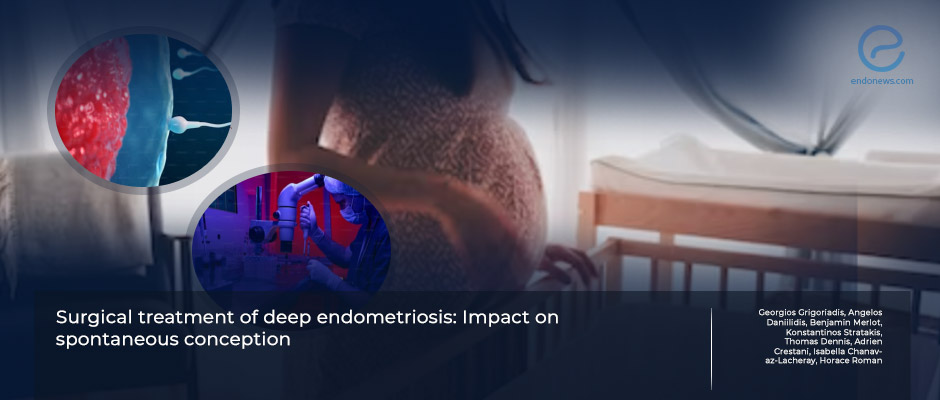Spontaneous Conception After Deep Endometriosis Surgery
Mar 1, 2024
Spontaneous conception rates are high in postoperative colorectal surgeries in the literature.
Key Points
Importance:
- Complex deep endometriosis (DE) surgery carries a risk of serious complications, even in expert centers.
Highlights:
- To increase the spontaneous conception rates for patients wishing to conceive, the debate between first surgery or first ART is still ongoing.
What's done here:
- An endometriosis expert team led by Dr.Horace penned this article to clarify the postoperative spontaneous conception chances after deep endometriosis surgery.
- The authors primarily focused on the studies of the literature reporting spontaneous pregnancy rates in women desiring to become pregnant with or without known preoperative infertility.
Basic outlines:
- Although the latest ESHRE guideline suggests that operative laparoscopy may be the treatment method for asymptomatic infertile women with DE, those surgeries are performed in different centers with different methods, and some factors, such as localization of DE lesions, can influence the result.
- In the literature, there are variable results about the spontaneous conception rate of the women operated on either by segmental bowel resection, discoid resection, or shaving methods. The results of retrospective and prospective studies vary, including the rates of spontaneous conception rate of 21% to 73%. Some prospective studies underlined the benefit of postoperative ART treatment in raising total conception rates.
- Retrospective studies on bladder and ureter surgeries applied to women with DE indicated spontaneous pregnancy rates after the surgery vary between 55% and 85%.
- Accompanying pathologies such as adenomyosis and oocyte maturation abnormalities negatively affect the spontaneous conception rate. Placenta previa, antepartum bleeding, preterm birth, and miscarriage are the obstetric complications of those women operated from deep endometriosis.
Lay Summary
Deep endometriosis is a severe form of endometriosis where lesions invade deeper than 5 mm into subperitoneal space. Surgical management of the disease is a challenging task requiring a multi-disciplinary approach and significant expertise in the field. Anastomotic leaks, fistula, and pelvic abscesses are reported in around 5% of colorectal surgeries, even in expert clinics.
Management of infertile women, particularly asymptomatic ones who are diagnosed with deep endometriosis, is open to debate between ART application or surgical approach. When the potential risk of complication associated with complex deep endometriosis surgery is taken into account, ART seems reasonable, particularly in asymptomatic women who are not motivated to conceive spontaneously. Reports are declaring livebirth rates up to 64% after 1 to 4 IVF attempts, even in advanced DE. In the real world, patients with DE wishing to conceive are more likely to go ART before surgery.
An expert endometriosis team led by Dr. Horace wrote this literature-based article to discuss the postoperative spontaneous conception rates of women with DE.
It is very important to remember that the operation of women with a diagnosis of complex DE should be achieved in a tertiary and expert clinic. Even so, some major complications could arise after colorectal surgeries due to the location and severity of the disease. Moreover, some unwanted obstetrical outcomes, such as placenta previa, miscarriage, antenatal hemorrhagia, and preterm birth, can dominate the scene.
There are reports on colorectal, ureter, and bladder surgery of DE in the literature, claiming a more than 50% success rate for postoperative spontaneous conceiving. "So far, surgery for DE should be considered to enhance chances of spontaneous conception, particularly in symptomatic women," concluded the authors in this recently published article in Best Practice & Research Clinical Obstetrics and Gynecology.
Research Source: https://pubmed.ncbi.nlm.nih.gov/38181664/
surgery complication infertility fertility outcomes spontaneous conception artificial reproductive technology deep endometriosis.

